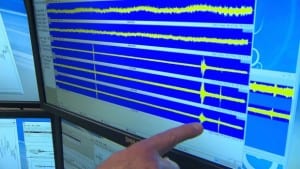Scientists had been observing smaller quakes in area; SMU seismology team has developed expertise to deploy instruments, analyze and sharedata
SMU’s seismology team was not surprised by the magnitude 4.0 earthquake that occurred near Venus, Texas, Thursday evening, having been aware of multiple smaller earthquakes identified by the United States Geological Survey (USGS) in the area in recent months. They are recommending a regional monitoring network.
“We emphasized to the House Committee on Energy Resources the need for a permanent regional network, supplemented by portable instruments, that we can deploy in a time-sensitive manner when earthquakes occur,” said Matthew Hornbach, SMU associate professor of geophysics.
“The seismology team at SMU has developed the expertise to deploy these instruments, analyze and share that data,” said Brian Stump, SMU Albritton Chair of Geological Sciences. “We are committed to cooperate, as resources allow, with both state and federal agencies in addressing these issues,” Stump said.
Currently SMU has 26 seismic instruments deployed in North Texas, split between an area near Azle, Texas, SMU, earthquakes, seismology that experienced a series of earthquakes from late 2013 through spring 2014, and along a fault straddling the Irving-Dallas, Texas, earthquakes, SMU, seismology line where earthquakes have been occurring near the site of the old Texas Stadium.
“We are in the process of determining what resources might be available so that we can respond to the largest earthquake now felt in North Texas,” said Heather DeShon, SMU associate professor of geophysics. Previous SMU deployments have relied heavily on loaned monitoring equipment from the USGS and the academic consortium known as IRIS – Incorporated Research Institutions for Seismology. “We are still in the process of determining how many instruments might be available for this purpose in light of ongoing earthquake activity around the world, such as the recent earthquake in Nepal,” DeShon said.
The magnitude 4.0 earthquake (M4) recorded by the USGS in Venus at 5:58 p.m. Thursday is part of a series of smaller earthquakes the SMU team has been following in the Midlothian area. The National Earthquake Information Center (NEIC) has reported seven earthquakes within 10 kilometers of the USGS location for the May 7 Venus earthquake, with three of them (including the most recent) occurring at or above magnitude 3. There have been 23 earthquakes recorded within 20 kilometers of the Venus location, since 2009, with five of them registering higher than an M3.
SMU first started studying earthquakes in Johnson County for a series of earthquakes occurring in Cleburne in 2009, culminating in the peer reviewed “Analysis of the Cleburne, Texas, Earthquake Sequence from June 2009 to June 2010 (doi: 10.1785/0120120336 Bulletin of the Seismological Society of America October 2013). The SMU team also is watching with interest an additional area of seismicity (based on USGS locations) near Mineral Wells.
“I don’t think any of us was surprised by Thursday’s event,” DeShon said. “There have been a series of magnitude 3 and greater earthquakes in the Johnson County area. If you have movement on a fault and change the stresses, you increase the likelihood of additional earthquakes. In other words, one earthquake frequently leads to another.”
The SMU team noted that the USGS web site for the event contains an analysis of the data that estimates fault motion striking from the northeast to the southwest – consistent with other earthquake sequences SMU has studied in North Texas.
“This illustrates that we all need to think about the possibility of larger earthquakes in the region where we live,” Stump said. — Kimberly Cobb

